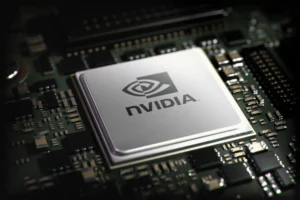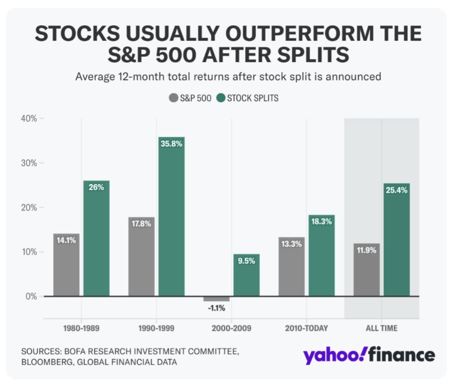By Ian Wyatt, Wyatt Investment Research, 2024-06-10

Nvidia (NASDAQ: NVDA) just completed a stock split.
Stock splits are typically good news for investors.
Stocks that complete a “split” typically rise 25% in the next year. Here's a chart from Yahoo! Finance showing the performance.

Nvidia just completed a 10-for-1 stock split.
That means existing shareholders received 10 shares of NVDA for every 1 share they owned last week.
Meanwhile, the share price of Nvidia was adjusted from $1,200 to $120 (reflecting 1/10 of the previous share price).
Nvidia shareholders didn't' see any change in the value of their position. However, data from Bank of America suggests that stocks that complete a split see returns that are 2x greater than the S&P 500.
Why do stocks that complete a “stock split” beat the market?
There are three primary reasons.
1. Affordability of Shares
When a company completes a “stock split” the price per share drops. This makes the stock seem more affordable to smaller investors.
For example, Nvidia at $1,200 per share seems expensive. At $120 it seems more affordable. This may attract investors who had previously not invested in the stock.
2. Increased Liquidity
Stock splits increase the number of shares outstanding. This can create more liquidity in the stock and options market. Greater liquidity can help increase the stock price.
3. Bright Outlook and Momentum
Companies typically split their stock because the business is strong and the stock price has been rising. This means that the business has already been strong and outperforming.
A company that completes a stock split may have seen shares outperform – regardless of the stock split.
Nvidia stock continues to trend higher thanks to the AI boom. Companies like Alphabet, Meta Platforms and Tesla are rushing to secure Nvidia's AI chips.
CEO Jensen Huang recently praised Tesla and it's new Robo.AI project.
This Artificial Intelligence breakthrough could be bigger than OpenAI and ChatGPT.
Ian Wyatt
The post Nvidia Stock Split: Why More Profits Are Coming appeared first on Wyatt Investment Research.





